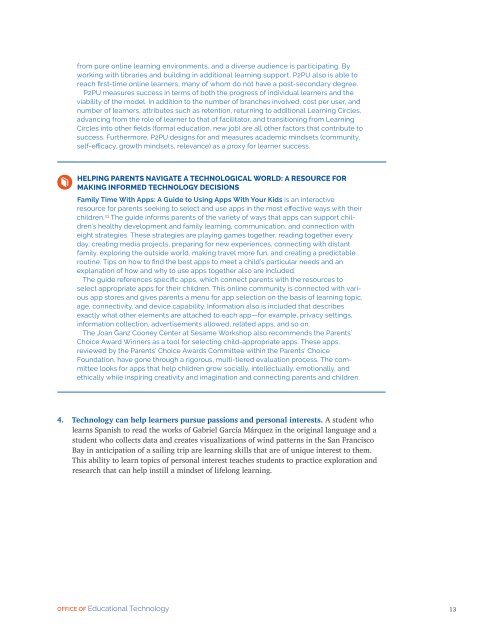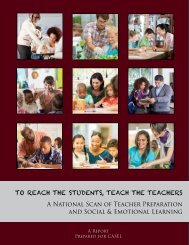Future Ready Learning
7m3sdJ
7m3sdJ
Create successful ePaper yourself
Turn your PDF publications into a flip-book with our unique Google optimized e-Paper software.
from pure online learning environments, and a diverse audience is participating. By<br />
working with libraries and building in additional learning support, P2PU also is able to<br />
reach first-time online learners, many of whom do not have a post-secondary degree.<br />
P2PU measures success in terms of both the progress of individual learners and the<br />
viability of the model. In addition to the number of branches involved, cost per user, and<br />
number of learners, attributes such as retention, returning to additional <strong>Learning</strong> Circles,<br />
advancing from the role of learner to that of facilitator, and transitioning from <strong>Learning</strong><br />
Circles into other fields (formal education, new job) are all other factors that contribute to<br />
success. Furthermore, P2PU designs for and measures academic mindsets (community,<br />
self-efficacy, growth mindsets, relevance) as a proxy for learner success.<br />
HELPING PARENTS NAVIGATE A TECHNOLOGICAL WORLD: A RESOURCE FOR<br />
MAKING INFORMED TECHNOLOGY DECISIONS<br />
Family Time With Apps: A Guide to Using Apps With Your Kids is an interactive<br />
resource for parents seeking to select and use apps in the most effective ways with their<br />
children. 33 The guide informs parents of the variety of ways that apps can support children’s<br />
healthy development and family learning, communication, and connection with<br />
eight strategies. These strategies are playing games together, reading together every<br />
day, creating media projects, preparing for new experiences, connecting with distant<br />
family, exploring the outside world, making travel more fun, and creating a predictable<br />
routine. Tips on how to find the best apps to meet a child’s particular needs and an<br />
explanation of how and why to use apps together also are included.<br />
The guide references specific apps, which connect parents with the resources to<br />
select appropriate apps for their children. This online community is connected with various<br />
app stores and gives parents a menu for app selection on the basis of learning topic,<br />
age, connectivity, and device capability. Information also is included that describes<br />
exactly what other elements are attached to each app—for example, privacy settings,<br />
information collection, advertisements allowed, related apps, and so on.<br />
The Joan Ganz Cooney Center at Sesame Workshop also recommends the Parents’<br />
Choice Award Winners as a tool for selecting child-appropriate apps. These apps,<br />
reviewed by the Parents’ Choice Awards Committee within the Parents’ Choice<br />
Foundation, have gone through a rigorous, multi-tiered evaluation process. The committee<br />
looks for apps that help children grow socially, intellectually, emotionally, and<br />
ethically while inspiring creativity and imagination and connecting parents and children.<br />
4. Technology can help learners pursue passions and personal interests. A student who<br />
learns Spanish to read the works of Gabriel García Márquez in the original language and a<br />
student who collects data and creates visualizations of wind patterns in the San Francisco<br />
Bay in anticipation of a sailing trip are learning skills that are of unique interest to them.<br />
This ability to learn topics of personal interest teaches students to practice exploration and<br />
research that can help instill a mindset of lifelong learning.<br />
OFFICE OF Educational Technology<br />
13



